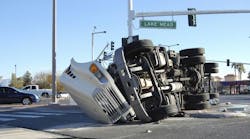I doubt there is a person in the trucking industry who doesn’t know and support the value of safety. Everyone says they want safer trucks on the road and manufacturers have responded by developing a number of products that increase vehicle safety. I am talking about things like electronic stability control, collision warning systems, lane departure warning systems, adaptive cruise control, etc.
However, Brian Collie, partner and managing director of Boston Consulting Group, a global management consulting firm, thinks the industry needs to speed up the adoption of these safety technologies.
Each year there are more than 4,000 fatalities in accidents involving heavy trucks. Plus there are the billions of dollars spent on property damage claims that result from truck-involved accidents.
Speaking at this fall’s Heavy Duty Manufacturers Association’s Breakfast & Briefing, Collie said that while progress has been made on adopting things like collision mitigation systems, other technologies like lane departure warning or drowsiness monitoring are not seeing widespread adoption.
Typically, when a fleet looks at making a technology investment, it looks at return on investment. I am not advocating that cost be tossed out the window when considering a safety technology, but make sure you fully understand the cost of an accident when deciding if a particular technology makes sense for you.
According to Federal Motor Carrier Safety Administration figures, the average cost of a truck accident is $148,279. That figure does not include things like lost productivity and damage to fleet reputation. And it does not reflect the damage to your CSA score, which can result in losing business if shippers don’t see you as a safe carrier.
Collie projected that over the next 13 years the trucking industry could save more than 10,000 lives if these advanced driver assistance systems become standard and are installed on all commercial vehicles from Class 3 through 8.
If you are not already investing in these safety systems, now is the time to at least begin to learn more about them and the benefits they provide so you can begin making appropriate investments.
As an added bonus, making sure your trucks have these safety technologies might help in your driver recruiting efforts. Drivers want to sign on with fleets that have demonstrated how much they value their drivers. An investment in safety technology is a great way to demonstrate just how important drivers are to your operation.



